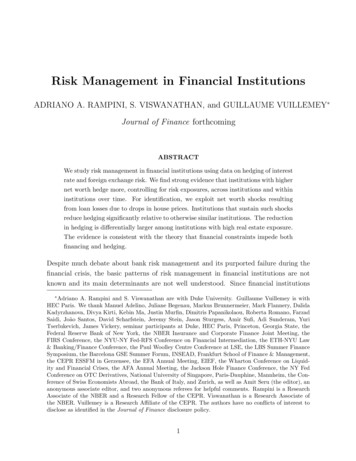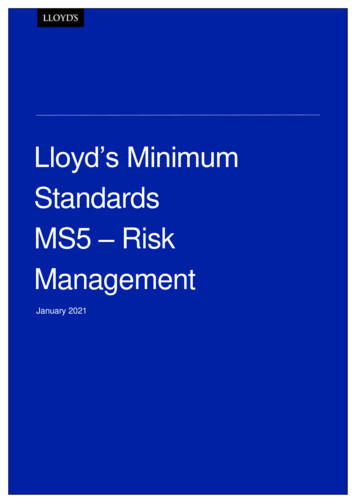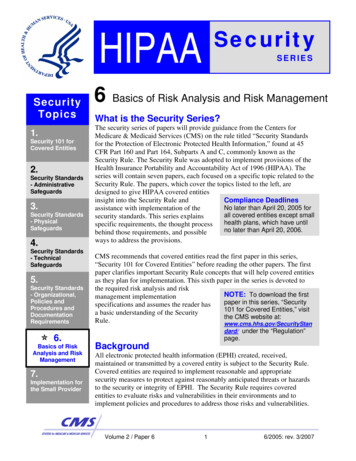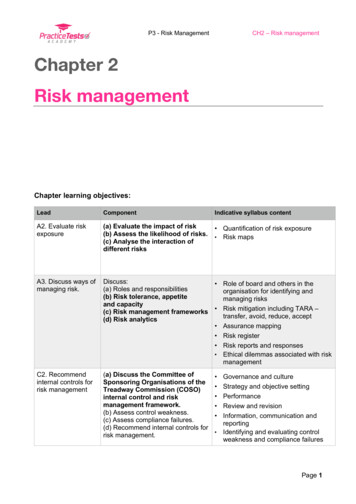
Transcription
Risk Management in Financial InstitutionsADRIANO A. RAMPINI, S. VISWANATHAN, and GUILLAUME VUILLEMEY Journal of Finance forthcomingABSTRACTWe study risk management in financial institutions using data on hedging of interestrate and foreign exchange risk. We find strong evidence that institutions with highernet worth hedge more, controlling for risk exposures, across institutions and withininstitutions over time. For identification, we exploit net worth shocks resultingfrom loan losses due to drops in house prices. Institutions that sustain such shocksreduce hedging significantly relative to otherwise similar institutions. The reductionin hedging is differentially larger among institutions with high real estate exposure.The evidence is consistent with the theory that financial constraints impede bothfinancing and hedging.Despite much debate about bank risk management and its purported failure during thefinancial crisis, the basic patterns of risk management in financial institutions are notknown and its main determinants are not well understood. Since financial institutions Adriano A. Rampini and S. Viswanathan are with Duke University. Guillaume Vuillemey is withHEC Paris. We thank Manuel Adelino, Juliane Begenau, Markus Brunnermeier, Mark Flannery, DalidaKadyrzhanova, Divya Kirti, Kebin Ma, Justin Murfin, Dimitris Papanikolaou, Roberta Romano, FarzadSaidi, João Santos, David Scharfstein, Jeremy Stein, Jason Sturgess, Amir Sufi, Adi Sunderam, YuriTserlukevich, James Vickery, seminar participants at Duke, HEC Paris, Princeton, Georgia State, theFederal Reserve Bank of New York, the NBER Insurance and Corporate Finance Joint Meeting, theFIRS Conference, the NYU-NY Fed-RFS Conference on Financial Intermediation, the ETH-NYU Law& Banking/Finance Conference, the Paul Woolley Centre Conference at LSE, the LBS Summer FinanceSymposium, the Barcelona GSE Summer Forum, INSEAD, Frankfurt School of Finance & Management,the CEPR ESSFM in Gerzensee, the EFA Annual Meeting, EIEF, the Wharton Conference on Liquidity and Financial Crises, the AFA Annual Meeting, the Jackson Hole Finance Conference, the NY FedConference on OTC Derivatives, National University of Singapore, Paris-Dauphine, Mannheim, the Conference of Swiss Economists Abroad, the Bank of Italy, and Zurich, as well as Amit Seru (the editor), ananonymous associate editor, and two anonymous referees for helpful comments. Rampini is a ResearchAssociate of the NBER and a Research Fellow of the CEPR. Viswanathan is a Research Associate ofthe NBER. Vuillemey is a Research Affiliate of the CEPR. The authors have no conflicts of interest todisclose as identified in the Journal of Finance disclosure policy.1
play a key role in the macroeconomy and the transmission of monetary policy, understanding their exposure to shocks is essential for monetary and macro-prudential policy.1Financial institutions can manage the risk exposures arising from lending and deposittaking activities using financial derivatives; indeed, financial institutions are the largestusers of derivatives, measured in terms of gross notional exposures. We study risk management in U.S. financial institutions using panel data on interest rate and foreign exchangerate derivatives positions which represent on average 94% and 5% of the notional valueof all derivatives used for hedging, that is, almost all the derivatives financial institutionsuse for hedging purposes.2We show that the net worth of financial institutions is a principal determinant of theirrisk management both across institutions and within institutions over time: institutionswith higher net worth hedge more and institutions whose net worth declines reduce hedging. To study the causal effect of net worth on hedging, we propose a novel identificationstrategy using net worth shocks resulting from loan losses which are in turn due to houseprice drops. Using difference-in-differences specifications, we find that institutions whichsustain such shocks reduce hedging of both interest rate and foreign exchange risk substantially relative to otherwise similar institutions. Using triple differences specificationsto control for differences in lending opportunities, we show that the reduction in bothtypes of hedging is differentially larger for institutions with higher real estate exposure,which sustain larger shocks to their net worth. We conclude that the financing needsassociated with hedging are a major barrier to risk management.We use theory to inform our measurement. A leading theory of risk managementargues that firms subject to financial constraints are effectively risk averse, giving theman incentive to hedge (see Froot, Scharfstein, and Stein (1993)). Given this rationale,Rampini and Viswanathan (2010, 2013) show that when financing and risk managementare subject to the same financial constraints, that is, promises to both financiers andhedging counterparties need to be collateralized, both require net worth and thus risk1Following Bernanke and Gertler (1989), the effects of the net worth of financial institutions on theavailability of intermediated finance and real activity are analyzed by Holmström and Tirole (1997),Gertler and Kiyotaki (2010), Brunnermeier and Sannikov (2014), and Rampini and Viswanathan (2019),among others. Empirically, the effects of bank net worth on lending and real activity are documented byPeek and Rosengren (1997, 2000), and its effects on employment are studied by Chodorow-Reich (2014).Financial institutions’ central role in the transmission of monetary policy is examined by Gertler andGilchrist (1994), Bernanke and Gertler (1995), Kashyap and Stein (2000), and Jiménez et al. (2012).2According to the BIS’ Derivative Statistics (December 2014), financial institutions account for morethan 97% of all gross derivatives exposures. Financial institutions’ derivatives positions for hedginginclude, in addition to interest rate and foreign exchange derivatives, equity derivatives (0.7%) andcommodity derivatives (0.1%). Not included in these calculations are credit derivatives, as no breakdownbetween uses for hedging and trading is available.2
management has an opportunity cost which is higher for more constrained firms. Thesame risk management concerns arise in the context of financial institutions (see Frootand Stein (1998) and Rampini and Viswanathan (2019)). Financial institutions facea trade-off between lending and risk management: financially constrained institutionsmust allocate their limited net worth between the two. Hedging has an opportunity costin terms of forgone lending. The main prediction is that more financially constrainedfinancial institutions, that is, institutions with lower net worth, hedge less; the cost offoregoing lending or cutting credit lines is higher at the margin for such institutions.We use panel data on U.S. financial institutions, focusing on bank holding companies. We first establish a new basic stylized fact about risk management in financialinstitutions: across institutions, financial institutions with higher net worth hedge interest rate and foreign exchange rate risk to a greater extent; and within institutions overtime, institutions whose net worth falls reduce hedging. We control for risk exposuresthroughout.We then test the main prediction of the theory using a novel identification strategyby focusing on drops in financial institutions’ net worth due to loan losses attributableto falls in house prices. We use 2009 as the treatment year and define treatment as institutions with a below median mortgage-weighted average local house price change in thetwo preceding years or a below median mortgage-weighted average local housing supplyelasticity.3 In difference-in-differences specifications using either definition of treatment,treated institutions reduce hedging economically and statistically significantly relative tootherwise similar control institutions; indeed, treated institutions cut hedging by as muchas one half. Similar results obtain when treatment and control group are propensity-scorematched. Treatment affects institutions’ net worth significantly, but not their risk exposures. This evidence corroborates the hypothesis that financial constraints are a majordeterminant of hedging.We use a triple differences specification to control for differences in lending opportunities, comparing the effect of treatment across terciles of institutions based on theirexposure to real estate. Treated institutions with higher real estate exposure reduce bothinterest rate and foreign exchange hedging differentially more, in fact, by about one half.We moreover show that for such treated institutions net worth also falls differentiallymore, whereas exposures do not change differentially. This suggests that the mechanism3A growing literature uses house prices to instrument for the collateral value of firms (see, for example,Chaney, Sraer, and Thesmar (2012)) and entrepreneurs (see, for example, Adelino, Schoar, and Severino(2015)). For financial institutions, a measure of local house prices in a similar spirit to ours, albeit at amore aggregated level, is used in several recent studies of the determinants of the supply of bank lending(see Bord, Ivashina, and Taliaferro (2018), Cuñat, Cvijanović, and Yuan (2018), and Kleiner (2015)).3
works via net worth as the theory predicts, rather than via lending opportunities orexposures.We do not think that our results are due to alternative hypotheses for several reasons. First, since our hedging variables are scaled by total assets, our results show thattreated institutions hedge less per unit of asset; thus a reduction in lending and assetsitself cannot explain our findings. Second, changes in interest rate risk exposures due tochanges in the lending environment are also not likely to drive our results, as we controlfor exposures throughout and show that treatment does not affect exposures; moreover,our results are similar for foreign exchange hedging, and arguably institutions’ foreign exchange exposures are not directly affected by the domestic lending environment. Third,our results cannot be due to differences in sophistication across institutions or fixed costsof hedging, since we measure the intensive margin of hedging and not just whether institutions hedge or not and since the results hold within institutions, that is, controllingfor institution fixed effects. Fourth, we do not think that the reduction of hedging byfinancially constrained institutions is evidence of risk shifting, because we find that theseinstitutions reduce derivatives trading at the same time, suggesting they take less risk, notmore. Furthermore, our results hold for institutions far away from distress, for which riskshifting incentives should be limited. Finally, we find that it is the net worth of financialinstitutions, that is, their economic value, which determines their hedging policy ratherthan their regulatory capital. Perhaps surprisingly, regulatory capital does not seem tobe a major determinant of risk management in financial institutions.Our paper is related to the literature on interest rate risk in banking. Purnanandam(2007) shows that the lending policy of financial institutions which engage in derivativeshedging is less sensitive to interest rate spikes than that of non-user institutions. Morerecently, Gomez et al. (2016) find that the exposure of financial institutions to interestrate risk predicts the sensitivity of their lending policy to interest rates. The interactionbetween monetary policy and banks’ exposure to interest rate risk is studied theoretically by Di Tella and Kurlat (2018) and empirically by Drechsler, Savov, and Schnabl(2017). Haddad and Sraer (2018) argue that banks’ balance sheet interest rate exposuresare largely determined by consumers’ demand for loans and deposits. Drechsler, Savov,and Schnabl (2018) argue that banks’ interest rate exposures may be more limited thancommonly thought, because deposit rates are more slow moving than their short-termmaturity suggests. Hoffmann et al. (2018) study the allocation of interest rate risk inthe banking sector, finding heterogenous bank exposures as well as limited hedging. Theoptimal management of interest rate risk by financial institutions is modeled by Vuillemey(2019). Begenau, Piazzesi, and Schneider (2015) quantify the exposure of financial insti-4
tutions to interest rate risk. They find economically large interest rate exposures bothin terms of balance sheet exposures and exposures due to the overall derivatives portfolios, which include trading and market-making positions. In contrast, our focus is onthe dynamic determinants of hedging by financial institutions based on risk managementtheory.This paper is also related to the literature on corporate risk management more broadly.Data availability presents a major challenge for inference regarding the determinants ofrisk management. Much of the literature is forced to rely on data that includes onlydummy variables on whether firms use any derivatives or not.4 In contrast, our dataprovides measures of the intensive margin of hedging, not just of the extensive margin.Further, much of the literature has access to only cross-sectional data or data with atbest a limited time dimension.5 Instead, we have panel data at the quarterly frequencyfor up to 19 years, that is, up to 76 quarters. This enables us to exploit the withinvariation separately from the between-variation. Like us, Rampini, Sufi, and Viswanathan(2014) have panel data on the intensive margin of hedging, albeit for a much smallersample of fuel price hedging by U.S. airlines. Another key difference is the identificationstrategy, as we are able to exploit exogenous variation in net worth due to house pricechanges. Furthermore, we provide new measures of net hedging and balance sheet riskexposures for financial institutions which allow better measurement. Finally, we focus onrisk management in the financial intermediary sector, which is of quantitative importancefrom a macroeconomic perspective and has received widespread attention both amongresearchers and policy makers.When describing the basic patterns of risk management, the existing literature hasmostly emphasized a strong positive relation between hedging and the size of firms andfinancial institutions.6 From the vantage point of previous theories, this positive relationhas long been considered a puzzle (see, for example, Stulz (1996)), because larger firmsare considered less constrained.7 The hypothesis which we test, in contrast, is consis4Guay and Kothari (2003) emphasize that such data may be misleading when interpreting the economic magnitude of risk management. Their hand-collected data on the size of derivatives hedgingpositions suggests that these are quantitatively small for most non-financial firms.5For example, Tufano (1996)’s noted study of risk management by gold mining firms uses only threeyears of data, although the data is on the intensive margin of hedging.6For firms, see Nance, Smith, and Smithson (1993), Mian (1996), and Géczy, Minton, and Schrand(1997). For financial institutions, Purnanandam (2007) shows that users of derivatives are larger thannon-users and Ellul and Yerramilli (2013) construct a risk management index to measure the strength andindependence of the risk management function at bank holding companies and find that larger institutionshave a higher risk management index, that is, stronger and more independent risk management.7Other theories of risk management include managerial risk aversion (see Stulz (1984)) and informa-5
tent with the observation that large financial institutions hedge more. Guided by thedynamic theory of risk management subject to financial constraints, we provide a muchmore detailed empirical characterization of the dynamic behavior of hedging by financialinstitutions, concluding that the key determinant of hedging is net worth, as measured byseveral variables, not size per se. Nonetheless, the fact that hedging is increasing in thesize of financial institutions is noteworthy, since it is contrary to what one might expectif Too-Big-To-Fail considerations were the main determinant of risk management.The paper proceeds as follows. Section I discusses the theory of risk management subject to financial constraints, and formulates our main hypothesis. Section II describes thedata and the measurement of interest rate and foreign exchange rate hedging by financialinstitutions. Section III establishes stylized facts on the relation between hedging andnet worth, and provides our identification strategy and empirical evidence. Section IVdiscusses the external validity and considers alternative hypotheses and Section V concludes.I.Risk Management subject to FinancialConstraintsFinancial constraints render financial institutions, and firms more broadly, effectivelyrisk averse, giving them an incentive to hedge. However, financial constraints impede riskmanagement at the same time. Indeed, when financing and risk management are subjectto the same constraints, Rampini and Viswanathan (2010, 2013) show that a trade-offarises: financially constrained institutions must choose between using their limited internal funds to make loans and using them for risk management purposes. In their dynamicmodel with collateral constraints, both promises to outside financiers and to hedgingcounterparties need to be collateralized; in other words, unencumbered collateral can beeither used to raise more funds to lend out or to back derivatives positions associatedwith risk management. Importantly, their model predicts that more constrained financialinstitutions hedge less, or not at all, that is, use their limited net worth to make loansinstead of committing scarce internal funds to risk management. The paradox of riskmanagement is that while financial constraints are the raison d’être for risk management,financial constraints are also the main impediment to risk management. As a consequence, the basic prediction of this theory is that less financially constrained institutionshedge more, that is, measures of hedging and net worth are positively related. This is thetion asymmetries between managers and shareholders (see DeMarzo and Duffie (1995) and Breeden andViswanathan (2016)); if anything, these theories would predict less hedging by large firms.6
prediction we test in our paper.8 While much of the literature considers risk managementin the corporate context, the same trade-off applies to financial institutions as well (seeFroot and Stein (1998) and Rampini and Viswanathan (2019)).9The key endogenous state variable in the model, which determines how financiallyconstrained institutions are and thus the extent of the trade-off is (economic) net worth.In the model, net worth is defined as net operating revenues plus assets minus liabilitiesplus the payoff of any hedging claims.10 Moreover, all else equal, institutions with highernet worth in the model also have higher value, deploy more capital (that is, have higherassets or loans), have higher net income, and pay higher dividends. Thus, value, size, netincome, and dividends are all positively related to net worth. Based on this reasoning, weuse these variables as proxies for net worth, since economic net worth itself is challengingto measure; in this spirit, we also construct a net worth index which is the first principalcomponent of these variables, all of which proxy for net worth. In addition, leverage inthe model is decreasing in net worth and, since ratings are decreasing in leverage, we canuse ratings as another proxy for net worth.Two features of the model are worth emphasizing. First, in the model, net worthis a key determinant of the size of an institution, and thus size is an important proxyfor net worth based on theory. Indeed, size plays a prominent role in most indices offinancial constraints in the literature. That said, differences in productivity and sourcesof heterogeneity outside the model could also result in variation in the size of institutionsin the data. To account for variation in size not driven by net worth, we scale somevariables, including value, net income, and dividends by assets. Scaling these variables8Froot, Scharfstein, and Stein (1993) show that financially constrained firms are risk averse in theamount of internal funds they have, giving them an incentive to hedge, and thus formalize this rationale for risk management. Their model predicts that financial institutions should completely hedge thetradable risks they face. Moreover, since risk management should not be a concern for unconstrainedinstitutions, they conclude that more financially constrained institutions should hedge more. In otherwords, their main prediction is that hedging is decreasing in measures of net worth, which is the oppositeof the prediction we test. This difference in predictions is due to the fact that, in their model, hedging isfrictionless and there is no concurrent investment with associated financing needs. In contrast, and consistent with the theory we test, Holmström and Tirole (2000) argue that credit-constrained entrepreneursmay choose not to buy full insurance against liquidity shocks, that is, incomplete risk management maybe optimal. Mello and Parsons (2000) also argue that financial constraints could constrain hedging.However, neither of these papers predicts the positive relation between hedging and net worth that weinvestigate here.9Vuillemey (2019) explicitly considers interest rate risk management in a dynamic quantitative modelof financial institutions subject to financial constraints and finds that interest rate risk management islimited and that the sign of the hedging demand for interest rate risk can vary across institutions, whichis important in interpreting the data below.10Net worth is also the key state variable in the literature on macro finance models with financialintermediaries summarized in footnote 1.7
by assets would also be appropriate in a constant-returns-to-scale version of the model.We discuss this in more detail in the next section. Second, the theory implies thatthe appropriate state variable is net worth, not cash, liquid assets, or collateral per se.Financial institutions’ net worth determines their willingness to pledge collateral to backhedging positions, use it to raise additional funding, or keep it unencumbered. In otherwords, available cash and collateral are endogenous. Net worth is defined as total assets,including the current cash flow, net of liabilities. Thus, it includes unused debt capacity,such as unused credit lines and unencumbered assets. Importantly, the fact that financialinstitutions hold large amounts of liquid assets on average does not imply that they areunconstrained or that the cost of collateral is low. Indeed, a large part of these securitiesare encumbered, for example, pledged as collateral in the repo market; there is thus asubstantial opportunity cost to encumbering additional assets to back derivatives hedgingtransactions.In the theory, expected productivity, that is, investment or lending opportunities, arean additional state variable. Lending opportunities increase the marginal value of networth in the model, making financial institutions more constrained, reducing hedging allelse equal. Therefore, to isolate the effect of net worth on hedging, it may be important tocontrol for potential changes in lending opportunities; we take this concern into account inour empirical strategy. Furthermore, any additional variation in exposures to risk factorsacross or within institutions outside the model would also affect the extent of hedging;we thus control for measures of exposures throughout.To sum up, theory predicts a positive relation between hedging and net worth, whichis the state variable affecting the extent of financial constraints. Theory also suggestsseveral variables, including value, size, net income, and dividends, which can serve asproxies for net worth. Finally, theory suggests that controlling for lending opportunitiesmay be important, as is controlling for exposures.II.Data and MeasurementThis section describes our data and the measurement of financial institutions’ hedging,exposures, and net worth.A.SampleWe use quarterly data on U.S. bank holding companies (BHCs). Our dataset comprisesbalance sheet data from the call reports (form FR Y-9C), market data from CRSP, S&Pcredit ratings data from Capital IQ, and mortgage origination data from HMDA. Specific8
descriptions for all variables are in Table AI in Appendix A. Our sample period starts in1995Q1, when derivatives data becomes available, and extends to 2013Q4. The mergedsample contains 22,723 BHC-quarter observations, that is, roughly 300 observations perquarter on average, for 76 quarters.11 We focus on BHC-level data due to the availabilityof market and credit ratings data. Each BHC controls one or several banks, and forclarity we refer to BHCs as financial institutions rather than banks.12 That said, similarresults obtain at the level of individual banks as we show in the Internet Appendix.B.Measurement of HedgingWe study both interest rate and foreign exchange hedging. We use two measures ofhedging, gross hedging and net hedging. Gross interest rate (IR) hedging by financialinstitution i at time t is measured asGross IR hedgingit Gross notional of interest rate derivatives for hedgingit,Assetsit(1)where the denominator is total assets and the numerator includes all interest rate derivatives, primarily swaps but also options, futures, and forwards, across all maturities. Grossforeign exchange (FX) hedging is measured analogously. Importantly, our measures include only derivatives used for hedging purposes, not trading, as the call reports dataallows us to distinguish between derivatives contracts “held for trading” and “held forpurposes other than trading,” that is, hedging.13Net hedging is the economically relevant variable, and gross hedging might hence bean imperfect measure, unless institutions’ hedging positions all have the same sign overthe measurement period. While net hedging is not directly reported by institutions, wepropose a new method to infer net interest rate hedging from reported data for BHCs.14Specifically, consider an institution with a net hedging position at date t with market11We drop U.S. branches of foreign financial institutions, because a large part of their hedging activitiesis likely unobserved. We also drop the six main dealers (Bank of America, Citigroup, Goldman Sachs,J.P. Morgan Chase, Morgan Stanley and Wells Fargo), since they engage in extensive market making inderivatives markets. However, our results are robust to the inclusion of these dealers.12BHCs can also engage in asset management or securities dealing. BHC-level data consolidatesbalance sheets of all entities within a BHC (see Avraham, Selvaggi, and Vickery (2012)).13Derivatives held for trading include (i) dealer and market making activities, (ii) positions taken withthe intention to resell in the short-term or to benefit from short-term price changes, (iii) positions takenas an accommodation for customers, and (iv) positions taken to hedge other trading activities.14Our measurement approach for BHC data is related to that of Begenau, Piazzesi, and Schneider(2015). In the Internet Appendix we propose a different approach for bank-level data which allows us toinfer net interest rate hedging for a subset of banks that only use interest rate swaps.9
value M Vt which is reported in our data. Suppose that between date t and t 1 themarket value changes by M Vt 1 M Vt 1 M Vt whereas the relevant benchmarkinterest rate changes by rt 1 rt 1 rt . Using the reported data, we infer institutions’net hedging as M Vit 1 /Assetsit.(2)Net IR hedgingit rt 1Intuitively, we infer the sign and magnitude of the hedging position at date t from thejoint dynamics of interest rates and the market value of the portfolio of interest ratederivatives between t and t 1: if the market value of the portfolio of interest ratederivatives goes up when interest rates go up, then the institution has a long position ininterest rate derivatives and vice versa. This measure is an approximation and may notperfectly capture expiring or new positions with non-zero market value between t andt 1, and implicitly assumes a one-factor (the short rate) model of the term structure.Moreover, we winsorize net hedging at the 5th and 95th percentiles to avoid outliers inquarters when rt 1 0.15 We anticipate here that we find very similar results usingour measures of gross and net hedging throughout.16C.Measurement of Net WorthThe key state variable in the theory is net worth; the marginal value of net worthreflects the extent of financial constraints and determines institutions’ risk managementpolicy. Since net worth as defined in the theory is only imperfectly measurable as discussed in Section I, we use two approaches to measurement. Our preferred measure is a“Net Worth Index” (denoted NWIndex) that we construct, defined as the first principalcomponent of four variables which are all positively correlated with net worth in theory:market capitalization over total assets, size (log total assets), net income over total assets,and dividends over total assets. Specifically, our net worth index is:NWIndexit 0.307 MktCapitNetIncitDivit 0.149 Sizeit 0.272 0.272 . (3)AssetsitAssetsitAssetsitWe observe that the net worth index loads most on market capitalization to assets (30.7%)and least on size (14.9%), in contrast to existing measures of financial constraints in theliterature, including the Whited-Wu Index (see Whited and Wu (2006)), which heavily15Alternatively, one could drop quarters in which (the absolute value of) the interest rate change isbelow the median from the sample; this approach yields comparable re
management has an opportunity cost which is higher for more constrained rms. The same risk management concerns arise in the context of nancial institutions (see Froot and Stein (1998) and Rampini and Viswanathan (2019)). Financial institutions face a trade-o between lending and risk management: nancially constrained institutions










